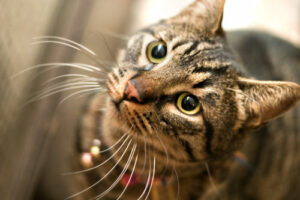
Whoops! Is your cat doing ‘nasties’ everywhere in the house except in its litter tray? House-soiling behaviour, or inappropriate elimination, can have many causes. Thankfully, there are solutions to this wee problem.
Could there be medical reasons for elimination problems?
Many medical diseases can cause a cat to lose its normal fastidious toileting habits, so a veterinary exam is required to differentiate these problems from behavioural problems.
This involves a physical examination, often urine or faeces tests, and sometimes diagnostics like blood tests and x-rays. For example, it is common for cats with cystitis to urinate small amounts in many different areas of the house, also diseases that make cats drink more will mean they need to urinate more, and if the littertray is already soiled, will seek other areas to urinate. Sometimes older cats with arthritis may find it difficult to get in and out of a tray with high sides, or to negotiate stairs to the littertray.
What about stress?
The presence of other cats around the house is a common cause of stress in cats, and may lead to the marking behaviour of spraying. The act of spraying involves the cat backing up to a surface, raising and quivering its tail, and treading with its back feet as a small amount of urine is directed backwards. Spraying is usually associated with territorial behaviour.
Separation anxiety is another cause of elimination problems. This is when the problem only occurs when the owner is away, and usually after a separation of more than 12 hours.
Stress and anxiety caused by a change in the household, or new cats in the area may require medical treatment to decrease anxiety, and this will make retraining the cat to use the litter tray much easier.
The litter tray could be the problem
The type of box, the type of litter, its location, and how often and with what it is cleaned are all factors influencing the cat’s decision to urinate elsewhere.
- Some prefer the privacy of covered boxes. If your cat prefers the bath or sink, use an empty litter tray (and put a few inches of water in your bath and sink.) If you find your cat prefers the potplants, try adding some soil to the litter
- There are all types of litter available ranging from clay, to clumping litter, to woodchips, to recycled newspaper
- The location of the tray is important – it needs to be somewhere the cat feels safe and private, and easy to access
- Most cats won’t use a soiled tray, so it needs to be cleaned frequently, without residual strong cleaning product odours. Soapy water is sufficient
- Most cats will use trays lined with newspaper with a handful of litter added – this allows the entire contents to be emptied and the tray cleaned each time
- If you are away during the day, add another litter tray. In multiple cat households, you need one tray per cat plus one extra
Retraining your cat to use the litter tray
To retrain your cat there are several measures you can take:
- Change the location. If there is one particular area the cat is using, put the litter tray there and gradually move it to the location you want the tray to be. Move it about 5cm a day.
- Change the litter tray. This could be the tray itself, the litter, frequency of cleaning, and cleaning agents.
- Decrease the attractiveness of the area the cat is using by cleaning it with an odour neutraliser, by feeding it there, or gluing several bits of dry food on an old saucer in the area. You can put its sleeping basket there, or place double sided sticky tape or aluminium foil in the area.
- Don’t allow access to the problem area. If your cat finds new areas to soil, you will need to confine it to rehousetrain it. Use the laundry to put bedding, water, and a litter tray in, (sometimes cages need to be used) and you may need to confine your cat for up to a month. It may be possible to allow your cat out of confinement for the first few hours after it has used the litter tray. This reward and some food treats serves as positive reinforcement for using the litter tray. With good behaviour, your cat is allowed more and more freedom and less supervision.
By Provet Resident Vet
Contributor: Dr Julia Adams BVSc
Last updated on 20 May 2021